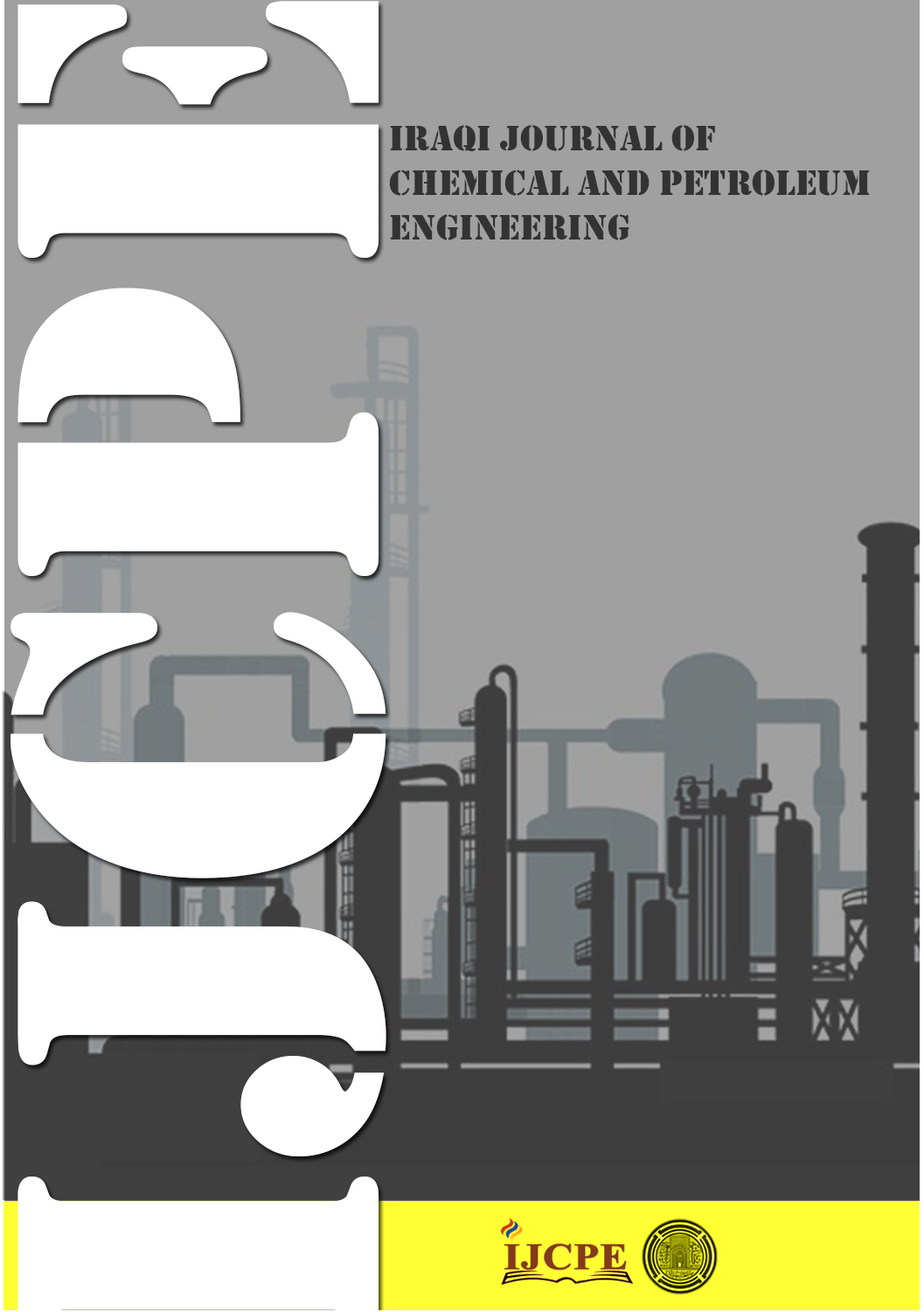Photocatalytic treatment of petroleum refinery wastewater by ZnO nanoparticles immobilized on a concrete substrate
DOI:
https://doi.org/10.31699/IJCPE.2025.3.10Keywords:
photocatalytic; immobilization; COD removal; ZnO nanoparticles; wastewaterAbstract
The petroleum industry's operations often involve substantial water usage, resulting in vast quantities of contaminated water, with a volume of the polluted water body estimated as about half the quantity of oil utilized in the refinement process. This wastewater contains various substances that are harmful to the health and environment, including hydrocarbons, heavy metals, and other toxic chemicals. This research aims to explore photocatalytic synthesis of zinc oxide nanoparticles to treat oil refinery wastewater. The effectiveness of this approach will be assessed by measuring the rate of Chemical Oxygen Demand (COD) reduction while identifying the best conditions to achieve the best performance and maximizing energy efficiency. Various operational conditions that drive the influence on the wastewater treatment process were investigated, including pH of 3, 5, 7, and 9, flow rate of 0.25, 0.5, 0.75, and 1.0 l/min, and the amount of the photocatalyst used per unit area (20, 40, 60, 80, 100 g/m2). Under optimum conditions, the photocatalytic method was applied with the following parameters: a COD of 1278 mg/l, a pH level of 7, a catalyst density of 80 g/m2, an effluent flow of 0.25 l/min, an irradiation power of 65 W, and an airflow of 100 cubic centimeters per minute. After 120 minutes, the COD reduction efficiency reached 76%, requiring energy consumption of 173.4 kW.hr/m3.
Received on 01/08/2024
Received in Revised Form on 28/10/2024
Accepted on 31/10/2024
Published on 30/09/2025
References
[1] Y. C. Chen, “Evaluating greenhouse gas emissions and energy recovery from municipal and industrial solid waste using waste-to-energy technology,” Journal of Cleaner Production, vol. 192, pp. 262–269, Aug. 2018, https://doi.org/10.1016/j.jclepro.2018.04.260
[2] X. L. Zou, “Treatment of heavy oil wastewater by UASB-BAFs using the combination of yeast and bacteria,” Environmental Technology (United Kingdom), vol. 36, no. 18, pp. 2381–2389, Sep. 2015, https://doi.org/10.1080/09593330.2015.1030346
[3] S. Varjani, R. Joshi, V. K. Srivastava, H. H. Ngo, and W. Guo, “Treatment of wastewater from the petroleum industry: current practices and perspectives,” Environmental Science and Pollution Research, vol. 27, no. 22, pp. 27172–27180, Aug. 2020, https://dx.doi.org/10.1007/s11356-019-04725-x
[4] M. M. Abdulredha, H. Siti Aslina, and C. A. Luqman, “Overview on petroleum emulsions, formation, influence and demulsification treatment techniques,” Arabian Journal of Chemistry, vol. 13, no. 1, pp. 3403–3428, Jan. 2018, https://doi.org/10.1016/j.arabjc.2018.11.014
[5] C. Eryılmaz and A. Genç, “Review of treatment technologies for the removal of phenol from wastewaters,” Journal of Water Chemistry and Technology, vol. 43, no. 2, pp. 145–154, 2021. https://doi.org/10.3103/S1063455X21020065
[6] T. Al-Khalid and M. H. El-Naas, “Organic Contaminants in Refinery Wastewater: Characterization and Novel Approaches for Biotreatment,” Recent Insights in Petroleum Science and Engineering, Feb. 2018, http://dx.doi.org/10.5772/intechopen.72206
[7] L. Yu, M. Han, and F. He, “A review of treating oily wastewater,” Arabian Journal of Chemistry, vol. 10, pp. S1913–S1922, May 2013, https://doi.org/10.1016/j.arabjc.2013.07.020
[8] D. A. D. A. Aljuboury, P. Palaniandy, H. B. Abdul Aziz, and S. Feroz, “Treatment of petroleum wastewater by conventional and new technologies - A review,” Global Nest Journal, vol. 19, no. 3, pp. 439–452, Nov. 2017, https://doi.org/10.30955/GNJ.002239
[9] C. Wang et al., “Refinery wastewater treatment via a multistage enhanced biochemical process,” Scientific reports, vol. 11, no. 1, Dec. 2021, https://doi.org/10.1038/S41598-021-89665-8
[10] S. Vendramel, J. P. Bassin, M. Dezotti, and G. L. Sant’Anna, “Treatment of petroleum refinery wastewater containing heavily polluting substances in an aerobic submerged fixed-bed reactor,” Environmental Technology (United Kingdom), vol. 36, no. 16, pp. 2052–2059, Aug. 2015, https://doi.org/10.1080/09593330.2015.1019933
[11] Y. Wang et al., “An alternative anaerobic treatment process for treatment of heavy oil refinery wastewater containing polar organics,” Biochemical Engineering Journal, vol. 105, pp. 44–51, Jan. 2016, https://doi.org/10.1016/j.bej.2015.08.012
[12] M. H. El-Naas, M. A. Alhaija, and S. Al-Zuhair, “Evaluation of a three-step process for the treatment of petroleum refinery wastewater,” Journal of Environmental Chemical Engineering, vol. 2, no. 1, pp. 56–62, Mar. 2014, https://doi.org/10.1016/j.jece.2013.11.024
[13] S. Zueva, V. Corradini, E. Ruduka, and F. Veglio, “Treatment of petroleum refinery wastewater by physicochemical methods,” E3S Web of Conferences, vol. 161, Apr. 2020, https://doi.org/10.1051/e3sconf/202016101042
[14] B. Singh and P. Kumar, “Pre-treatment of petroleum refinery wastewater by coagulation and flocculation using mixed coagulant: Optimization of process parameters using response surface methodology (RSM),” Journal of Water Process Engineering, vol. 36, Aug. 2020, https://doi.org/10.1016/j.jwpe.2020.101317
[15] M. Dehghani and M. H. Alizadeh, “The effects of the natural coagulant Moringa oleifera and alum in wastewater treatment at the Bandar Abbas Oil Refinery,” Environmental Health Engineering and Management, vol. 3, no. 4, pp. 225–230, Nov. 2016, http://dx.doi.org/10.15171/EHEM.2016.24
[16] K. Abuhasel, M. Kchaou, M. Alquraish, Y. Munusamy, and Y. T. Jeng, “Oilywastewater treatment: Overview of conventional and modern methods, challenges, and future opportunities,” Water (Switzerland), vol. 13, no. 7, Apr. 2021, https://doi.org/10.3390/w13070980
[17] Y. Zhang, X. Quan, S. Chen, Y. Zhao, and F. Yang, “Microwave assisted catalytic wet air oxidation of H-acid in aqueous solution under the atmospheric pressure using activated carbon as catalyst,” Journal of hazardous materials, vol. 137, no. 1, pp. 534–540, Sep. 2006, https://doi.org/10.1016/j.jhazmat.2006.02.036
[18] E. E. Ebrahiem, M. N. Al-Maghrabi, and A. R. Mobarki, “Removal of organic pollutants from industrial wastewater by applying photo-Fenton oxidation technology,” Arabian Journal of Chemistry, vol. 10, pp. S1674–S1679, May 2013, https://doi.org/10.1016/j.arabjc.2013.06.012
[19] C. Chen et al., “Catalytic ozonation of petroleum refinery wastewater utilizing Mn-Fe-Cu/Al2O3 catalyst,” Environmental Science and Pollution Research, vol. 22, no. 7, pp. 5552–5562, Apr. 2015, https://doi.org/10.1007/s11356-015-4136-0
[20] J. Rashid, M. A. Barakat, Y. Ruzmanova, and A. Chianese, “Fe3O4/SiO2/TiO2 nanoparticles for photocatalytic degradation of 2-chlorophenol in simulated wastewater,” Environmental Science and Pollution Research, vol. 22, no. 4, pp. 3149–3157, Feb. 2015, https://doi.org/10.1007/s11356-014-3598-9
[21] S. Somiya, “Handbook of Advanced Ceramics,” Handbook of Advanced Ceramics: Materials, Applications, Processing, and Properties: Second Edition, May 2013, https://doi.org/10.1016/C2010-0-66261-4
[22] W. J. Lau, A. F. Ismail, A. M. Isloor, and A. Al-Ahmed, “Advanced nanomaterials for membrane synthesis and its applications,” Advanced Nanomaterials for Membrane Synthesis and Its Applications, pp. 1–341, Nov. 2019, https://doi.org/10.1016/C2017-0-01081-9
[23] I. J. Ani, U. G. Akpan, M. A. Olutoye, and B. H. Hameed, “Photocatalytic degradation of pollutants in petroleum refinery wastewater by TiO2-and ZnO-based photocatalysts: recent development,” Journal of cleaner production, vol. 205, pp. 930–954, 2018, https://doi.org/10.1016/j.jclepro.2018.08.189
[24] S. J. Park, J. H. Yang, M. H. Joo, and Y. Sohn, “Current status, research gaps, and future scope for nanomaterials toward visible light photocatalysis,” Nanostructured Materials for Visible Light Photocatalysis, pp. 569–608, Oct. 2022, https://doi.org/10.1016/B978-0-12-823018-3.00001-4
[25] D. al deen A. Ali, P. Palaniandy, and Shaik. Feroz, “Advanced Oxidation Processes (AOPs) to Treat the Petroleum Wastewater,” 2018, IGI Global: Hershey, PA, USA., Jul. 2019, https://doi.org/10.4018/978-1-5225-5766-1.CH005
[26] A. Sushma and A. Yadav, “Biological and physicochemical combination processes,” Nanomaterials for Air Remediation, pp. 361–372, Feb. 2020, https://doi.org/10.1016/B978-0-12-818821-7.00018-X
[27] M. R. Al-Mamun, S. Kader, M. S. Islam, and M. Z. H. Khan, “Photocatalytic activity improvement and application of UV-TiO2 photocatalysis in textile wastewater treatment: A review,” Journal of Environmental Chemical Engineering, vol. 7, no. 5, Oct. 2019, https://doi.org/10.1016/j.jece.2019.103248
[28] M. Baradaran and F. E. Ghodsi, “Investigation of the properties of oxide-based multilayer thin films and their use in the photocatalytic applications,” Chemical Solution Synthesis for Materials Design and Thin Film Device Applications, pp. 697–715, Jan. 2021, https://doi.org/10.1016/B978-0-12-819718-9.00018-2
[29] M. B. Tahir, M. Sohaib, M. Sagir, and M. Rafique, “Role of Nanotechnology in Photocatalysis,” Encyclopedia of Smart Materials, pp. 578–589, Jan. 2022, https://doi.org/10.1016%2FB978-0-12-815732-9.00006-1
[30] S. Das and S. Dhara, “Chemical Solution Synthesis for Materials Design and Thin Film Device Applications,” Chemical Solution Synthesis for Materials Design and Thin Film Device Applications, pp. 1–730, Jan. 2021.
[31] M. Delnavaz, B. Ayati, H. Ganjidoust, and S. Sanjabi, “Optimization of photo-catalytic process by TiO2 nano powder immobilized on concrete surface for treatment of phenolic wastewater,” Environmental Engineering & Management Journal, vol. 10, no. 10, 2011, https://doi.org/10.30638/eemj.2011.206
[32] J. R. Bolton, K. G. Bircher, W. Tumas, and C. A. Tolman, “Figures-of-merit for the technical development and application of advanced oxidation technologies for both electric-and solar-driven systems (IUPAC Technical Report),” Pure and Applied Chemistry, vol. 73, no. 4, pp. 627–637, 2001. https://doi.org/10.1351/pac200173040627
[33] A. S. Fahem and A. H. Abbar, “Treatment of petroleum refinery wastewater by electro-Fenton process using porous graphite electrodes,” Egyptian Journal of Chemistry, vol. 63, no. 12, pp. 4805–4819, Dec. 2020, https://dx.doi.org/10.21608/ejchem.2020.28148.2592
[34] K. Selvam, M. Muruganandham, I. Muthuvel, and M. Swaminathan, “The influence of inorganic oxidants and metal ions on semiconductor sensitized photodegradation of 4-fluorophenol,” Chemical Engineering Journal, vol. 128, no. 1, pp. 51–57, Mar. 2007, https://doi.org/10.1016/j.cej.2006.07.016
[35] M. Keramati and B. Ayati, “Petroleum wastewater treatment using a combination of electrocoagulation and photocatalytic process with immobilized ZnO nanoparticles on concrete surface,” Process Safety and Environmental Protection, vol. 126, pp. 356–365, Jun. 2019, https://doi.org/10.1016/j.psep.2019.04.019
[36] M. Delnavaz, “Photo catalysis of wastewater containing phenol mediated by Nano TiO2 fixed to concrete surface,” Topics in Catalysis, 58, 1085–1099, 2015, https://doi.org/10.1007/s11244-015-0477-7
[37] Z. Ghasemi, H. Younesi, and A. A. Zinatizadeh, “Preparation, characterization and photocatalytic application of TiO2/Fe-ZSM-5 nanocomposite for the treatment of petroleum refinery wastewater: Optimization of process parameters by response surface methodology,” Chemosphere, vol. 159, pp. 552–564, Sep. 2016, https://doi.org/10.1016/j.chemosphere.2016.06.058
[38] J. Saien and F. Shahrezaei, “Organic pollutants removal from petroleum refinery wastewater with Nano titania photocatalyst and UV light emission,” International Journal of Photoenergy, vol. 2012, no. 1, p. 703074, 2012. https://doi.org/10.1155/2012/703074
[39] J. Saien and H. Nejati, “Enhanced photocatalytic degradation of pollutants in petroleum refinery wastewater under mild conditions,” Journal of hazardous materials, vol. 148, no. 1–2, pp. 491–495, 2007, https://doi.org/10.1016/j.jhazmat.2007.03.001
[40] N. R. Kadhim, H. M. Flayeh, and A. H. Abbar, “Kinetic Modeling of Electro membrane Extraction of Copper using a Novel Electrolytic Cell Provided with a Supported Liquid Membrane,” Iraqi Journal of Chemical and Petroleum Engineering, vol. 24, no. 4, pp. 39–46, Dec. 2023, https://doi.org/10.31699/IJCPE.2023.4.4
[41] Z. Zeitoun, A. H. El-Shazly, S. Nosier, M. R. Elmarghany, M. S. Salem, and M. M. Taha, “Performance evaluation and kinetic analysis of photocatalytic membrane reactor in wastewater treatment,” Membranes (Basel), vol. 10, no. 10, pp. 1–18, Oct. 2020, https://doi.org/10.3390/membranes10100276
[42] G. G. Sonai, S. M. A. G. U. de Souza, D. de Oliveira, and A. A. U. de Souza, “The application of textile sludge adsorbents for the removal of Reactive Red 2 dye,” Journal of environmental management, vol. 168, pp. 149–156, Mar. 2016, https://doi.org/10.1016/j.jenvman.2015.12.003
[43] H. D. Tran, D. Q. Nguyen, P. T. Do, and U. N. P. Tran, “Kinetics of photocatalytic degradation of organic compounds: a mini-review and new approach,” RSC advances, vol. 13, no. 25, pp. 16915–16925, Jun. 2023, https://doi.org/10.1039/D3RA01970E
[44] N. A. Mohammed, A. I. Alwared, and M. S. Salman, “Photocatalytic degradation of reactive yellow dye in wastewater using H2O2/TiO2/UV technique,” Iraqi Journal of Chemical and Petroleum Engineering, vol. 21, no. 1, pp. 15–21, 2020, https://doi.org/10.31699/IJCPE.2020.1.3
Downloads
Published
Issue
Section
License
Copyright (c) 2025 The Author(s). Published by College of Engineering, University of Baghdad.

This work is licensed under a Creative Commons Attribution 4.0 International License.













